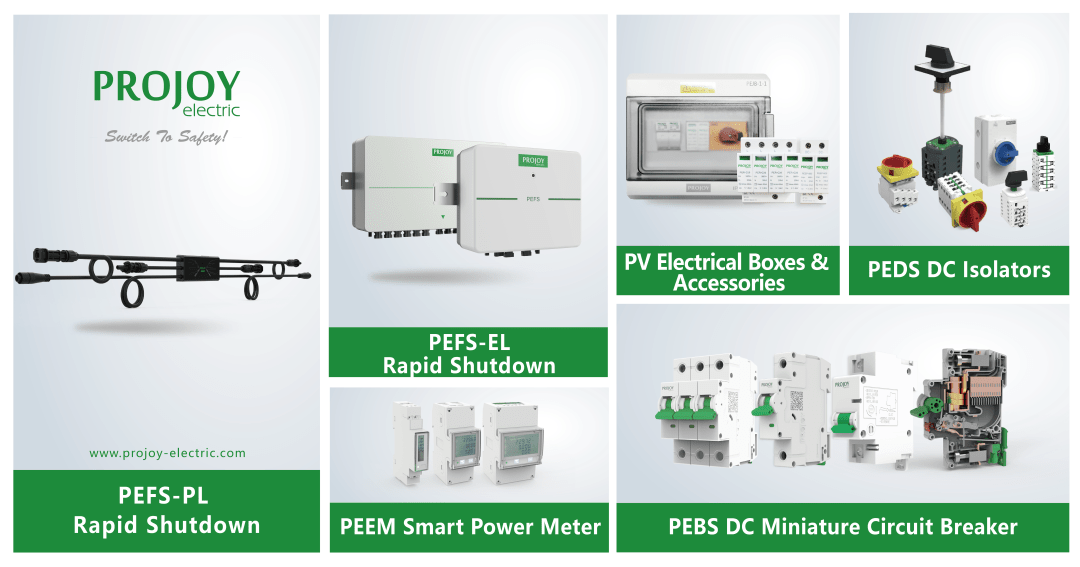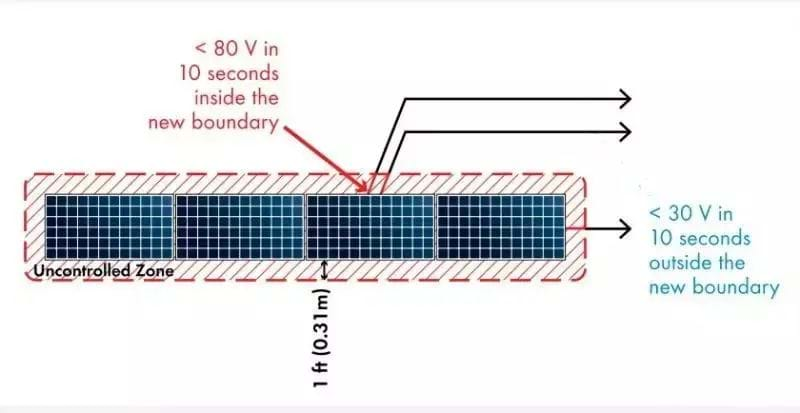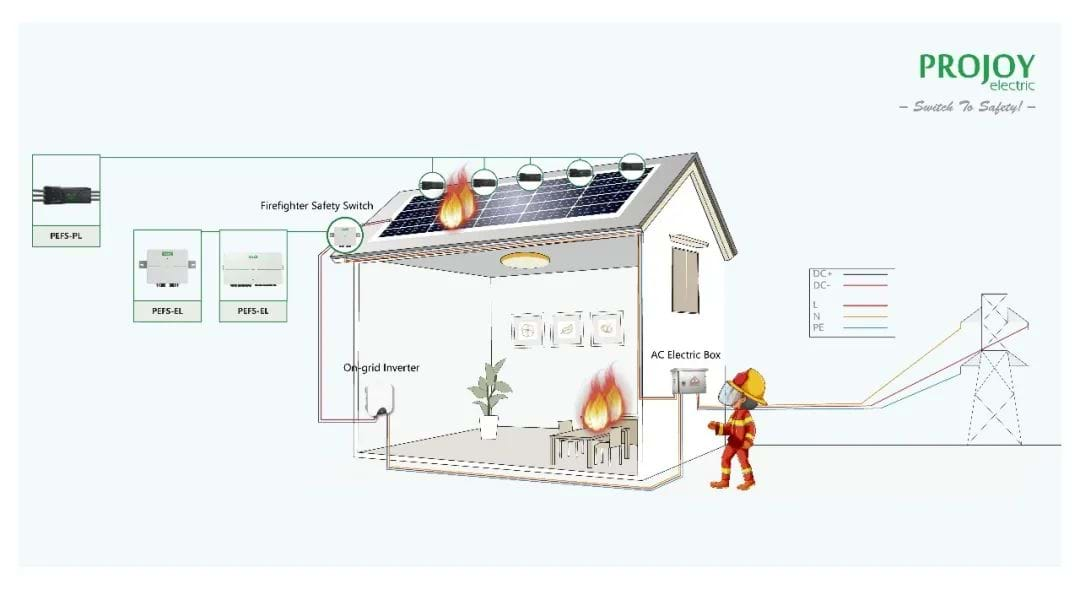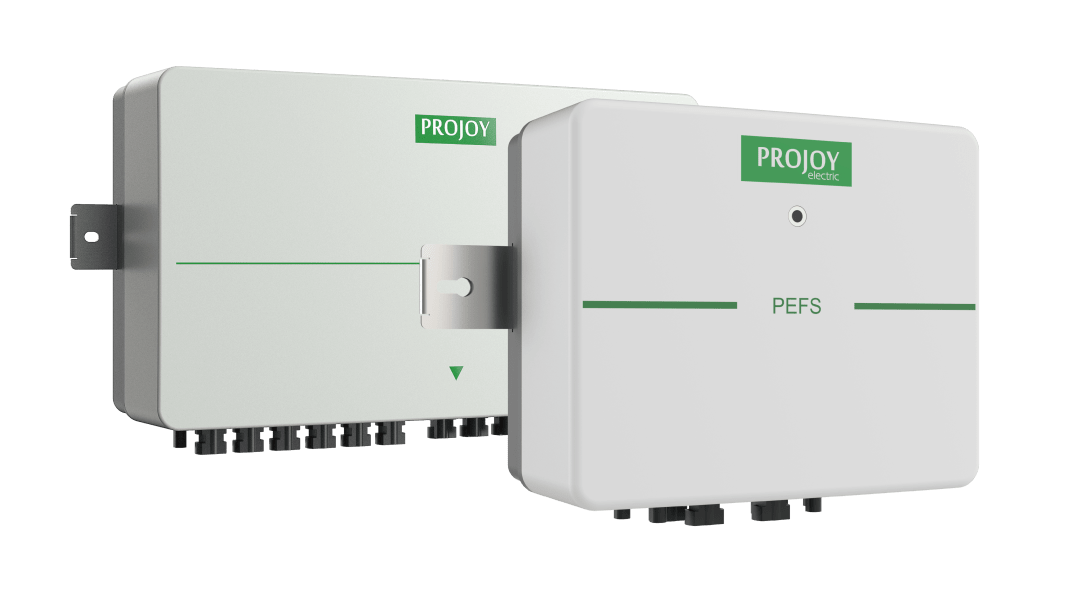Projoy Classroom | Lesson 3 PV Rapid Shutdown
Date: 2022-03-24In the previous two lessons, we introduced DC isolators and circuit breakers. This lesson: PV Rapid Shutdown.

What is PV Rapid Shutdown?
PV rapid shutdown is a device that can quickly shut down the photovoltaic power generation system. The concept was first proposed by the National Electrical Code (NEC) in the United States. After years of updating, a strict standard has been formed: the photovoltaic system must have a "photovoltaic risk control system", so that the photovoltaic system is in a critical situation. When the situation is in a controllable state, the "photovoltaic danger control system" is used to turn off the photovoltaic system. Within 30S after the device is started, the voltage outside the limit range is reduced to below 30V, and the voltage within the boundary range is reduced to below 80V.

< Schematic diagram of NEC terms>
Why photovoltaic systems need rapid shutdown?
Photovoltaic power plants are easy to catch fire and difficult to rescue.
In a high-voltage photovoltaic system , problems such as module hot spots, string mismatch , cable damage, tight connections, and dust accumulation on the inverter can easily cause the photovoltaic power station to catch fire. The operation and maintenance time of photovoltaic power plants is 25 years. As the equipment ages, the probability of fire accidents increases exponentially. However, when a fire occurs, if only the AC power from the inverter to the grid is turned off, there will still be hundreds or even thousands of volts of high voltage on the DC side between the panels and between the panels and the inverter. It will endanger the lives of firefighters. In this case, maybe just let it burn...
The rapid shutdown can cut off the current between the panels and the inverter or between the panels, creating a safe rescue environment for firefighters, reducing fire losses, and ensuring personal and property safety.

<Schematic diagram of rapid shutdown operation >
How to choose the right rapid shutdown product?
In this context, various photovoltaic companies have launched their own rapid shutdown products. However, at present, the built-in DC switches of some photovoltaic rapid shutdowns on the market are mostly AC switches or their improved products. The arc extinguishing capacity and rated load cut-off power of these switches are not enough, and they are prone to overheating, deformation, and even fire. They can not really ensure fire safety, but bring greater safety hazards to the photovoltaic system.
Then, in the face of the uneven rapid shutdown market, how to find the most suitable product has become the most concerned issue for users. In this regard, Projoy Electric made the following summary for users:
1. Choose professional and well-known brands, especially that have passed international certification
In general, rapid shutdown has CE-LVD, CE-EMC, TUV, UL certifications. Its built-in DC isolators (Array-level ) mainly include IEC60947-3 (European general standard, Asia-Pacific applicable), UL508 (American general standard), UL508i ( American standard for DC switches for photovoltaic systems), GB14048.3 (domestic standard) Common Criteria) and so on. At present, major international brands with professional design, R&D and manufacturing capabilities have all the above certifications, such as Projoy Electric.
2. Choose a brand with complete product models and perfect technology, marketing and after-sales service network
Rapid shutdown of well-known brands usually have complete power segments. For example, Projoy has various series ranging from single panel level to 1500V/50A multi-group array level. It focuses on the design, development, and production of DC isolators and rapid shutdowns for photovoltaic systems.And has a high market share and brand awareness in the segmented field.
Generally, there are many types of rapid shutdown of big brands to meet the needs of different occasions, such as the panel-level rapid shutdown for a single component, and the array-level rapid shutdown for string-type components. Projoy 's rapid shutdown is available in various voltage and current levels, external control boxes with and without locks, and various colors. The panel-level is subdivided into PLC type and DC24V type, one fits one, one fits two and so on . To meet the diverse needs of customers in different regions and different needs, the perfect technical support, marketing and after-service network can ensure that the product can be served in time during the use process, and truly achieve peace of mind when buying and using.
3. Choose a brand with complete functions such as intelligent shutdown, emergency shutdown and remote shutdown, automatic reset after power failure and power recovery
First of all, the rapid shutdown should have the function of automatically detecting the ambient temperature and automatically shutting down over temperature. This function plays an important role in cutting off the high-voltage direct current at the first time of a fire . Especially on the unattended roofs of some homes or factories.
Second, the rapid shutdown should comply with international standards for firefighter work procedures. When a fire occurs in the photovoltaic system, personnel can directly manually press the emergency stop button to cut off the AC power of the rapid shutdown control box; on the other hand, they can also directly connect to the fire alarm system to directly cut off the AC power at the first time of the fire, and quickly shut down.The AC loss signal will be collected, and the isolator switch will be automatically disconnected to disconnect the DC side, creating a safe environment for firefighters.
Finally, when power is restored after AC power has been shut down (such as during a power outage), rapid shutdown can automatically reset and quickly connect the circuit. Do not need to reset manually every time.
4. Choose a brand with high on-off capability and good arc -extinguishing effect
On-off capability and arc -extinguishing effect are one of the most important indicators for evaluating rapid shutdown. The real rapid shutdown has a special arc extinguishing device, and the arc extinguishing effect is very good. For example, there is no direct connection between the handle and the contacts of the spring energy storage switching device built-in the array-level rapid shutdown. When on and off, the contacts are not directly rotated and disconnected. When the handle rotates or moves to a specific point, the spring triggers all the contacts suddenly disconnect, so a very fast on-off action is generated, which greatly shortens the arcing time. Others, such as contact pairs, special self-cleaning design, and arc-extinguishing magnets , also have a great effect on the arc-extinguishing effect. Generally, the arc of the international first-line brand rapid shutdown can be extinguished within a few milliseconds. For example, Projoy's array-level rapid shutdown can extinguish the arc within 5ms, while the arc generally improved from AC lasts for about 100ms.
5. Choose brands with high flame retardant and protection grades
Generally, the rapid shutdown is mostly installed outdoors, which requires high flame retardant properties and protection properties, and the protection level must reach at least IP65. Some rapid shutdown enclosures are made of plastic with flame retardant properties, and can meet the high standard of UL94V-0. There are also a few metal enclosures, but these need to be grounded again, otherwise there is a safety risk of leakage of the enclosure.

<Projoy Array-level Rapid Shutdown >
Rapid shutdown selection steps in photovoltaic systems ?
1. Confirm local safety regulations and budgeted costs
According to national and regional regulations, such as the US market, if there are mandatory regulatory requirements for module voltage, only panel-level rapid shutdown can be selected; if there is no mandatory requirement , array-level rapid shutdown can be selected according to the configuration and cost of the photovoltaic system. Compared with panel-level rapid shutdown, array-level rapid shutdown has more obvious cost advantages, but it also has some drawbacks. For example, the panel-level rapid shutdown can cut off the voltage between each panel, the array-level rapid shutdown can cut off the DC voltage that exists between the entire panel and the inverter.
2. Need to understand the influence of altitude, ambient temperature, etc. on model selection
The rapid shutdown is installed between the panel and the inverter, and its selection is generally preliminarily estimated through key parameters, while taking into account environmental factors such as altitude and extreme temperature to leave sufficient margin. The output power of panels in a photovoltaic system is affected by weather, ambient temperature, inverter MPPT tracking, etc. Second, the inverter itself is limited by the maximum allowable input DC voltage and current, and is also affected by temperature. For example, when the irradiance is constant, within a certain temperature range, the short-circuit current increases with the increase of temperature, and the open-circuit voltage increases with the decrease of temperature.
3. Analyze the environment used and installation method
Determine the operating temperature, protection, and fire rating of the rapid shutdown according to the environment. Generally speaking, if the quality is good, it should work normally at -25°C to 70°C, the protection level should be at least IP65, and the fire rating should reach UL94V-0. For outdoor use, require a waterproof vent valve.
4. Determine voltage and current of the system and string
The selected rapid shutdown allowable maximum voltage needs to meet the PV panel or system voltage requirements, and the open-circuit voltage of the panel is subject to the actual PV panel electrical parameters. The system voltage is 600V-1500V. Generally, the system voltage connected to the single-phase inverter is 600V, and the system voltage of the three-phase string type or power station type inverter reaches 1500V.
The selection of rapid shutdown refers to the following experience:
●Voltage=Ns× Voc ×1.15
●Current=Np× Isc ×1.25
●Ns - the number of photovoltaic panels in series to be interrupted
●Np - the number of photovoltaic panels in parallel to be interrupted
●Voc - panel open circuit voltage
●Isc - Panel short circuit current
●1.15 and 1.25 are empirical coefficients
Generally, the rapid shutdown of the big brands can disconnect the 1000V system DC voltage, and even can disconnect the 1500V DC input.
In addition, it is impossible for photovoltaic panels to always work at the maximum open-circuit voltage and short-circuit current. In order to save costs reasonably, the maximum power point voltage and current can also be used as a reference for array-level rapid shutdown:
Voltage=Ns× Vmppt ×1.15
Current=Np× Imppt ×1.25
5. Determine the number of components or strings to be interrupted
For the panel-level rapid shutdown, the quantity must be determined within the range that meets the breaking voltage;
For the array-level rapid shutdown, the quantity must be greater than the number of strings;
Multiple rapid shutdowns can be used if a single rapid shutdown is not sufficient.
6. Determine the specific model
On the basis of satisfying the above conditions, it is necessary to select a specific model from the favored brands. Generally, it is difficult to find a rapid shutdown that is completely matched, and there is a certain margin to choose a specification higher than the theoretical calculation. Common ones are 16A, 25A and 32A, and some large manufacturers have 40A, 55A, 1000V or 1500V rated voltage levels.

<Projoy Panel-level Rapid Shutdown >
Based on the above points, I believe that you can choose the most suitable rapid shutdown product according to your needs.
At present, countries such as Europe and the US have more and more perfect laws and regulations for rapid shutdown. Although domestically, due to a series of factors such as cost, it is still difficult to fully promote the installation of rapid shutdown, but relevant safety standards have been gradually introduced. It can be seen that rapid shutdown is a very important function for the safety of photovoltaic power plants.
It is believed that with the continuous advancement of technology, the popularization and implementation of safety regulations, and the gradual strengthening of safety awareness, more and more rapid shutdowns will escort more power stations.